Showing Spotlights 153 - 160 of 627 in category All (newest first):
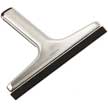 By precisely stacking various 2D materials in a predetermined sequence on top of each other, researchers create van der Waals heterostructures that, due to their unique interlayer coupling, have special optoelectronic properties. Unfortunately, the study of 2D monolayers is plagued by trapped contaminants in between the 2D sheets as well as between the 2D sheets and the underlying substrate. These contaminants make it difficult to obtain precise and reproducible experimental observations. A simple technique for removing these contaminants in a process similar to a squeegee.
By precisely stacking various 2D materials in a predetermined sequence on top of each other, researchers create van der Waals heterostructures that, due to their unique interlayer coupling, have special optoelectronic properties. Unfortunately, the study of 2D monolayers is plagued by trapped contaminants in between the 2D sheets as well as between the 2D sheets and the underlying substrate. These contaminants make it difficult to obtain precise and reproducible experimental observations. A simple technique for removing these contaminants in a process similar to a squeegee.
May 1st, 2018
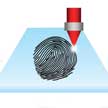 Creating smart superhydrophobic (i.e. extremely water-repellent) surfaces is of increasing importance in cutting-edge applications such as self-cleaning, anti freezing, anticorrosion, anti biofouling, water/oil separation, and microfluidics. Researchers now managed to demonstrate a skin-like superhydrophobic surface, which can be switched into different wetting properties by simple body motion. This active surface enables on-demand manipulation of water droplets without energy supply or external appliance.
Creating smart superhydrophobic (i.e. extremely water-repellent) surfaces is of increasing importance in cutting-edge applications such as self-cleaning, anti freezing, anticorrosion, anti biofouling, water/oil separation, and microfluidics. Researchers now managed to demonstrate a skin-like superhydrophobic surface, which can be switched into different wetting properties by simple body motion. This active surface enables on-demand manipulation of water droplets without energy supply or external appliance.
Apr 24th, 2018
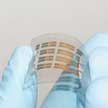 Next-generation electronic devices will be highly portable, wearable - even transplantable - lightweight, and most likely self-powered. Among the various functional block required for these systems (such as displays, sensors, actuators, etc), some of the most important components are novel flexible data storage systems that possess nonvolatile ability, high-density storage, high-switching speed, and reliable endurance properties. Especially organic memories have been considered as the most promising candidates to be used in various portable and wearable systems in future due to their remarkable advantages of nonvolatile memory features, low cost, easy fabrication, and flexibility.
Next-generation electronic devices will be highly portable, wearable - even transplantable - lightweight, and most likely self-powered. Among the various functional block required for these systems (such as displays, sensors, actuators, etc), some of the most important components are novel flexible data storage systems that possess nonvolatile ability, high-density storage, high-switching speed, and reliable endurance properties. Especially organic memories have been considered as the most promising candidates to be used in various portable and wearable systems in future due to their remarkable advantages of nonvolatile memory features, low cost, easy fabrication, and flexibility.
Apr 9th, 2018
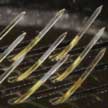 Whiskers on animals allow them to build a rich understanding of their environment by feeling objects or even the flow of fluids. Many animals can also actively sweep, or 'whisk', their whiskers, enabling them to gather complex information about the architecture of their environment. Researchers have replicated this whisking action by exploiting the shape memory effect of a polymer substrate, which can be dynamically repositioned by modulating the temperature and air flow across the electronic whiskers (e-whiskers).
Whiskers on animals allow them to build a rich understanding of their environment by feeling objects or even the flow of fluids. Many animals can also actively sweep, or 'whisk', their whiskers, enabling them to gather complex information about the architecture of their environment. Researchers have replicated this whisking action by exploiting the shape memory effect of a polymer substrate, which can be dynamically repositioned by modulating the temperature and air flow across the electronic whiskers (e-whiskers).
Apr 3rd, 2018
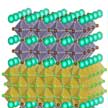 Halide perovskites have attracted tremendous interest due to their fascinating optoelectronic properties. Driven by the concerns of toxicity derived from lead and instability caused by organic components, researchers have turned to all-inorganic lead-free halide perovskites. However, compared to hybrid lead perovskite, lead-free compositions usually demonstrate poor crystallinity, low ordering, and high defects that suppress the performance of optoelectronic devices. Scientists now have deployed a new approach to grow all inorganic lead-free halide perovskites.
Halide perovskites have attracted tremendous interest due to their fascinating optoelectronic properties. Driven by the concerns of toxicity derived from lead and instability caused by organic components, researchers have turned to all-inorganic lead-free halide perovskites. However, compared to hybrid lead perovskite, lead-free compositions usually demonstrate poor crystallinity, low ordering, and high defects that suppress the performance of optoelectronic devices. Scientists now have deployed a new approach to grow all inorganic lead-free halide perovskites.
Mar 29th, 2018
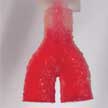 Imagine being able to print out healthy tissue with just a sample of a patient's own cells. While printed replacement human body parts might seem like science fiction, the use of 3D printing technologies for medical applications is a relatively new but rapidly expanding research field, although still quite a way from clinical application for treating patients. However, currently available bioinks cannot 3D print self-sustaining anatomic-size structures containing live cells. To overcome the limitations of existing bioinks, researchers have developed a highly printable bioink for fabricating large scale, cell-laden, bioactive scaffolds.
Imagine being able to print out healthy tissue with just a sample of a patient's own cells. While printed replacement human body parts might seem like science fiction, the use of 3D printing technologies for medical applications is a relatively new but rapidly expanding research field, although still quite a way from clinical application for treating patients. However, currently available bioinks cannot 3D print self-sustaining anatomic-size structures containing live cells. To overcome the limitations of existing bioinks, researchers have developed a highly printable bioink for fabricating large scale, cell-laden, bioactive scaffolds.
Mar 20th, 2018
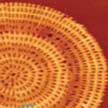 Given the vast, and still rising, cost of optical lithography tools, researchers have considered alternative patterning technologies such as electron beam lithography (EBL), and nanoimprint technology (NIL) in order to enable the manufacturing of next-generation integrated circuits, flash memory, and hard disk drives. Now that the length scales attainable by top-down lithography are approaching that of bottom-up self-assembly found in polymers and small molecules, scientists are increasingly looking at bottom-up patterning technologies based on self-assembly.
Given the vast, and still rising, cost of optical lithography tools, researchers have considered alternative patterning technologies such as electron beam lithography (EBL), and nanoimprint technology (NIL) in order to enable the manufacturing of next-generation integrated circuits, flash memory, and hard disk drives. Now that the length scales attainable by top-down lithography are approaching that of bottom-up self-assembly found in polymers and small molecules, scientists are increasingly looking at bottom-up patterning technologies based on self-assembly.
Mar 9th, 2018
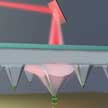 The past two decades have witnessed the evolution of advanced physical probe-based nanolithography techniques for molecular printing such as for instance Dip-Pen Nanolithography. Now, researchers have demonstrated, for the first time, photo-actuated polymer pens for molecular printing. This represents an important step in the field of scalable nanofabrication. It paves the way for dynamic actuation of individual pens, making it possible to realize patterning and printing molecules or other soft materials such as polymers or biomaterials at high resolution and low cost.
The past two decades have witnessed the evolution of advanced physical probe-based nanolithography techniques for molecular printing such as for instance Dip-Pen Nanolithography. Now, researchers have demonstrated, for the first time, photo-actuated polymer pens for molecular printing. This represents an important step in the field of scalable nanofabrication. It paves the way for dynamic actuation of individual pens, making it possible to realize patterning and printing molecules or other soft materials such as polymers or biomaterials at high resolution and low cost.
Feb 23rd, 2018
 By precisely stacking various 2D materials in a predetermined sequence on top of each other, researchers create van der Waals heterostructures that, due to their unique interlayer coupling, have special optoelectronic properties. Unfortunately, the study of 2D monolayers is plagued by trapped contaminants in between the 2D sheets as well as between the 2D sheets and the underlying substrate. These contaminants make it difficult to obtain precise and reproducible experimental observations. A simple technique for removing these contaminants in a process similar to a squeegee.
By precisely stacking various 2D materials in a predetermined sequence on top of each other, researchers create van der Waals heterostructures that, due to their unique interlayer coupling, have special optoelectronic properties. Unfortunately, the study of 2D monolayers is plagued by trapped contaminants in between the 2D sheets as well as between the 2D sheets and the underlying substrate. These contaminants make it difficult to obtain precise and reproducible experimental observations. A simple technique for removing these contaminants in a process similar to a squeegee.
 Subscribe to our Nanotechnology Spotlight feed
Subscribe to our Nanotechnology Spotlight feed





